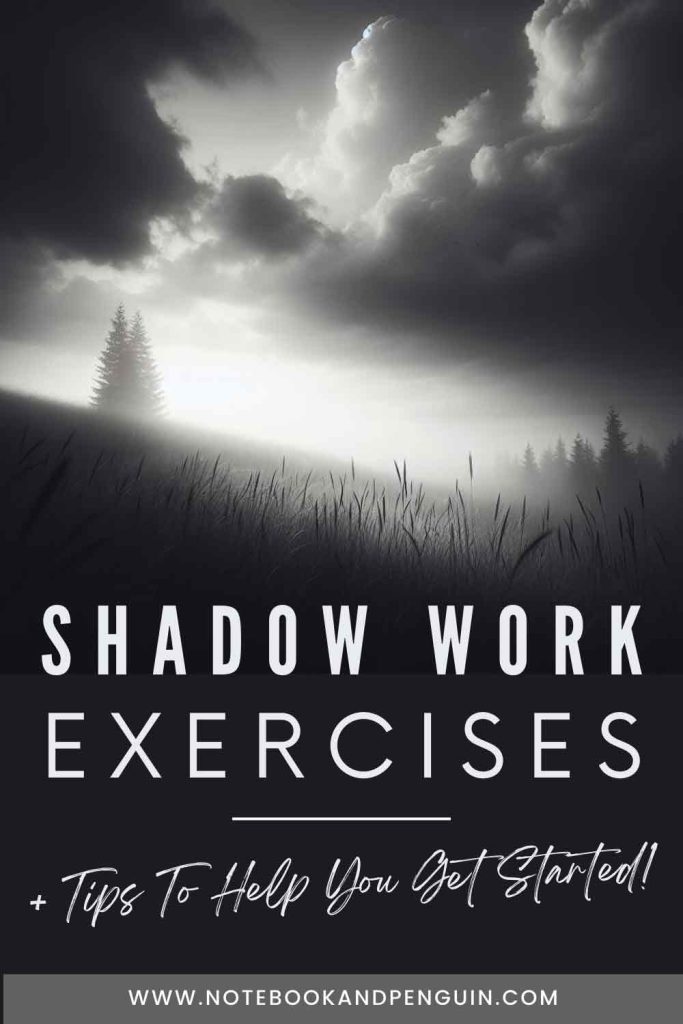

Shadow Work Exercises & Tips To Help You Get Started
If you are new to shadow work then you might be wondering exactly how to get started. In this article, I would like to give you some practical shadow work exercises and tips that you can begin using today to help you explore your shadow self which I hope will ultimately lead to a more authentic and fulfilling life for you!
Although at face value these exercises might seem easy, they can be a really powerful way of exploring the unconscious mind with many benefits when it comes to personal growth. That said, sometimes shadow work can be challenging, so it is important to take care of yourself especially if you have never done this type of work before.
Pin To Your Shadow Work Board For Later…

Shadow Work Exercises
Journaling
My favorite shadow work method is of course journaling! Journaling is one of the most powerful shadow work tools around. It allows you to explore your memories, personality traits, thoughts, and feelings in a safe and reflective space and there is just something about putting pen to paper that allows you to express yourself in the most authentic way possible!
Getting started: Set aside some time each day to journal about your thoughts, feelings, and experiences. Write down anything that comes to mind, without judgment or censorship. Allow yourself to explore your deepest fears, desires, and emotions.
Tips: Use prompts like “What am I afraid of?” or “What am I angry about?” to help you get started. Write freely and without editing yourself. Also, check out our article on the 12 shadow archetypes to get a really interesting take on how our thoughts, emotions, and behaviors can be affected by this theory.
Check out our giant list of over 150 Shadow Work Prompts to help you get started! I’ve broken down the list of prompts into handy sections so that you can explore different aspects of your life such as relationships, your childhood, anxieties, etc.
Self-Awareness
One of the best shadow work exercises I’ve found is building a habit of self-awareness by intentionally becoming aware of your thoughts, emotions, and behavior.
By learning to observe your own reactions to yourself, the people around you, and the things that happen in your life, you get a better understanding of how your shadow self manifests in your everyday life.
An example: You are having a conversation with one of your parents or a good friend and you suddenly find yourself feeling a bit irritated or defensive. You can’t explain exactly why you feel the way you do but you just can’t shake the feeling that they might be judging you in some way. You start to feel anxious and you might begin to withdraw or even lash out at them.
In this example, the shadow could be manifesting itself as a feeling of defensiveness or irritation even though the other person doesn’t intend to criticize or judge you. It is a subtle unconscious reaction to a perceived threat or criticism and could be rooted in a deep-seated insecurity or fear that you are not consciously aware of.
Tips: Start becoming aware of your emotional reactions towards others and record the feelings that you experience in your journal. Explore these feelings to see whether they are valid or if they might be masking some underlying issue that you need to explore.
Also, learn to pay attention to the voices that run through your mind throughout your day. Take note of any self-criticism or judgments that you have towards yourself or others and explore these in your journal as well.
Meditation
Mediation is another effective way to explore your shadow. It helps you to quiet your mind and focus your attention inward allowing you to connect with your inner self.
Combining meditation with journaling can be really powerful!
Getting started: Find a place that is quiet and comfortable to sit or lie down. Close your eyes and focus on your breathing. With each breath out, allow yourself to relax and let go of any tension or stress that you might have in your body.
When you are completely relaxed, use one of the above prompts to start questioning and exploring different parts of your mind. Allow your mind to wander exploring any uncomfortable feelings or memories that come up. If you are using a journal, write down everything you experience.
Tips: Use music or guided meditations to help you relax and focus. You can also try visualization techniques, such as imagining a light or a warmth spreading throughout your body as you relax.
Active Imagination
Active imagination is a technique developed by Carl Jung, the psychiatrist who first wrote about the shadow self. His method uses things like guided imagery, visualization, daydreaming, talking to your inner self, and creativity to actively and intensionally explore your dreams, fantasies, and unconscious thoughts.
Getting started: Find a comfortable place to sit or lie down. Close your eyes and imagine yourself in a place that feels safe and relaxing. Allow yourself to become fully immersed in your imagination taking note of the thoughts, images, sensations, and feelings that you experience.
Allow yourself to explore your darker feelings and emotions knowing you are in a safe place. Use your imagination to transform these feelings and emotions into tangible objects you can interact with.
For example, if you feel angry, you could imagine your anger as a fierce fire-breathing dragon! Imagine talking to the dragon and trying to understand why he is angry. Are there any underlying emotions he might have which have led him to become angry? Is he feeling disappointed in something? Is he frustrated? Is he lonely?
Tips: Use all of your senses to bring the imagination to life. Imagine sights, sounds, smells, tastes, and textures. Allow yourself to interact with your imagined world and explore your deepest desires and fears.
Dreamwork
Jung believed that our dreams are like a window to our unconscious mind and they show us things that we may not be aware of in our waking lives. You can get a better understanding of different aspects of your shadow by analyzing and exploring your dreams.
Getting started: Keep a dream journal next to your bed and write down your dreams in detail as soon as you wake up.
Tips: Put time aside to completely explore the emotions that you felt during each dream. Think about the symbols and messages that you recognized in your dreams and think about what your unconscious mind might be trying to tell you.
Dialogue With Your Inner Self
Use your journal to have a conversation with your inner self or a part of your personality that you’d like to explore. Ask questions, listen to the responses, and engage in a conversation to help you get a better understanding of your thoughts, feelings, and behaviors.
Getting started: Use your journal to write a dialogue between yourself and your shadow. Allow yourself to be completely open and express your deepest fears, desires, and emotions. Remember to write freely without worrying about things like grammar and spelling.
Sometimes it can be helpful to do this shadow work exercise with a timer. Set a timer and begin writing. Try to write without thinking or censoring yourself. When your time is up you can go back and explore what you have written more deeply.
Tips: Use prompts like “What are you afraid of?” or “What do you desire?” to help you get started.
Creative Expression
You can use things like art, music, or creative writing in your shadow work to express how you feel in a more creative way. This is sometimes easier for people who prefer to express themselves in a more non-verbal way.
Getting started: Choose a creative activity that you enjoy, such as drawing, painting, poetry, or music. As you work, allow yourself to become fully immersed in the activity and try to express your deepest emotions and desires without judgment or criticism.
Tips: Again, use shadow work prompts to help you get started. For example, if you ask yourself “How am I feeling?”, draw your emotion or create a piece of music that captures how you feel at that moment. If you are painting or drawing try using color to express your emotions.
Related: Learn how shadow work can help you to unlock your creativity.
Working With A Shadow Work Partner
Working with a shadow work partner can be a great way to explore your shadow with someone who is willing to support you on your journey. Your shadow work partner can be someone who is also exploring their own shadow self or someone like a friend, family member, coach, or therapist that you trust and feel comfortable with.
Getting started: Before starting shadow work with a partner it is important that you are both on the same page and that you feel safe and supported working with each other. For shadow work to work it is important to be open and honest with your partner so you need to feel that you can share your thoughts, emotions, and experiences without fear of judgment or criticism.
Tips: Choose a couple of shadow work questions and prompts that you and your partner can work through. For example, “What are my deepest fears?” “What am I ashamed of?” “What am I hiding from others?”. Often it is helpful to write your responses down in your journal and then discuss and explore them with your partner. You can take turns talking about your answers while offering each other support and encouragement.
You can also use shadow work quotes to explore other people’s perspectives on what shadow work is.
Another great way of working with a shadow work partner is using role-playing to explore different scenarios that you have noticed trigger your shadow. For example, if you are scared of public speaking, practice giving a speech in front of your partner and see how your shadow reacts. How do you feel? Where do these feelings come from? Why do you feel the way you do? What can you do to minimize these feelings?
Therapy
And finally, remember that shadow work can also be done in therapy with the help of a trained therapist. A therapist can help and guide you in a safe and supportive way giving you more insight into what you are feeling and experiencing.
Shadow Work Tips To Get You Started
If you are ready to practice shadow work, here are a few more tips to help you get started:
Start small – Begin with small, manageable steps, such as keeping a journal or practicing meditation for a few minutes a day.
Be patient – Shadow work is a process that takes time, patience, and dedication. Be patient with yourself and allow yourself the time and space to explore your unconscious mind.
Be kind to yourself – Shadow work can be challenging because you will be confronting parts of yourself that you may have been trying to avoid. Allow yourself to feel your emotions and work through anything that comes up without criticism or judgment.
Self-care – Remember to take care of your physical, mental and emotional health while doing shadow work. This could involve doing simple things you enjoy like going for a walk, meditating, reading, or visiting a friend.
Embrace your shadow – Remember that your shadow is a part of you and you become a more whole and complete person when you embrace it with acceptance, love, and an open heart.
Look for support – If you feel like you need extra support then consider working with a therapist or joining a shadow work support group where you can meet people who are on the same journey as you.
Note: If you have experienced trauma or are experiencing distressing thoughts or behaviors that you cannot manage on your own, it’s important to seek help from a qualified mental health professional.
A trained therapist can help you develop coping strategies and can help you work through underlying issues in a safe and supportive space. Remember seeking help is a sign of strength, not weakness and it’s okay to ask for help and support when you need it.
Conclusion
I hope that these shadow work exercises and tips will help you as you start doing shadow work! Let me know in the comments section which shadow work method is your favorite and how it helped you on your shadow work journey.






